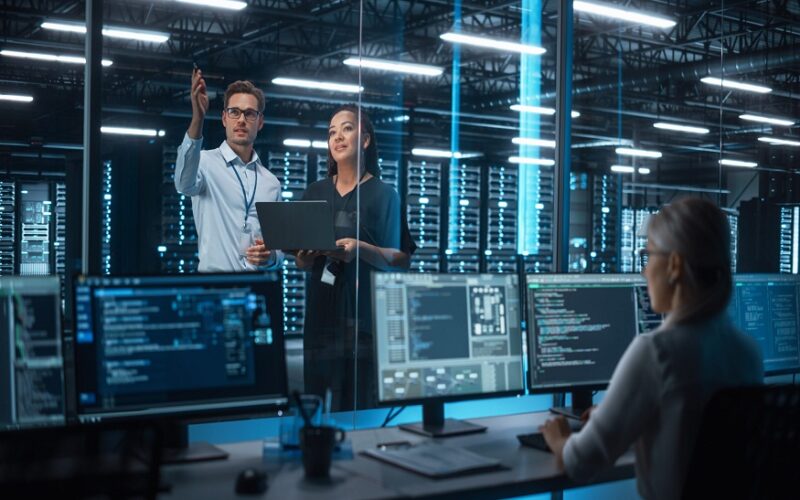There is a huge change happening in the way we develop, run, and protect IT infrastructure. This year’s biggest cloud infrastructure conference has shown where the industry is going and how organisations can remain ahead. They spoke about everything from AI-driven automation to the rise of hybrid clouds.
It is important for IT leaders, cloud architects, and infrastructure specialists to grasp these developments. What the experts believe regarding the future of infrastructure is as follows:
Hybrid and Multi-Cloud are Now the Standard
We no longer have to argue over whether to put all our eggs in one cloud provider’s basket. The events of this year have made it evident that hybrid and multi-cloud configurations are the new normal. Companies want to be able to change things up without being locked into a vendor, but still getting the best performance and lowest prices.
Managing identities, encryption, and compliance across various clouds is a big issue that needs new tools and techniques. Expect to see more money going into unified cloud management tools that make it easier to run things across AWS, Azure, GCP, and private data centres.
What is the main point? Infrastructure personnel now need to know how to make systems operate together so that data can flow smoothly and workloads can move across environments.
AI and Automation are Changing how Infrastructure is Managed
AI wasn’t simply a buzzword; it was the main topic of many conversations. AI-driven automation is changing the way infrastructure is watched over and cared for, from predictive maintenance to self-healing networks.
At the conference, demonstrations showed AI technologies that find problems in real time and immediately provide resources to keep things running well. Some platforms now utilise machine learning to decrease expenses and carbon footprints by making data centres consume less electricity.
The message was clear: IT teams who use AIOps (AI for IT operations) would have less work to do by hand, work more quickly, and fix problems before they become worse.
Edge Computing is Speeding Up, But It’s Also Bringing New Problems
Edge computing isn’t just a thing of the future anymore; it’s here now and developing quickly. With IoT, 5G, and real-time analytics requiring low latency, processing data closer to the source is increasingly crucial.
However, the speakers pointed out several big problems: security at the edge is not well-organised, and it is still hard to manage a large distributed infrastructure. New solutions are coming out to help with these problems, such as AI-driven orchestration tools and edge-native security frameworks.
The message for organisations is clear: if you aren’t already preparing for edge installations, you might lose speed and customer satisfaction.
Zero Trust is Growing Beyond Just Network Security
Zero Trust Architecture (ZTA) came up a lot, but in a new way: it’s not simply about networks anymore. The emphasis has grown to include protecting identities, workloads, and even the supply chains for hardware.
Speakers made it clear that Zero Trust has to encompass the whole infrastructure stack, from APIs to microservices. New frameworks are being developed to guarantee least-privilege access in hybrid systems, which makes it harder for attackers to get in.
The bottom line? Zero Trust is changing from a security approach to a basic philosophy of infrastructure.
Observability Takes the Role of Traditional Monitoring
It’s not enough to just have logs and analytics anymore. Full-stack observability, which means putting together data from applications, networks, and infrastructure, was a big trend.
Vendors showed out technologies that use AI to aggregate traces, logs, and analytics to provide you useful information. What is the goal? Going from fixing problems after they happen to fixing them before they happen.
This implies that IT teams need to buy new observability tools that provide them a complete picture, not simply tools that just show them what’s going on in one area.
The Need for More Skills is What is Driving the Use of Infrastructure as Code (IaC).
Because there aren’t enough IT workers, automation is no longer an option. Infrastructure-as-Code (IaC) solutions like Terraform and Pulumi were hot topics, allowing teams to provide and manage infrastructure programmatically.
Workshops showed how IaC cuts down on mistakes, speeds up deployments, and makes sure that environments are all the same. Another interesting thing was the advent of AI-assisted IaC, where tools offer ways to make things better.
The decision? Managing infrastructure by hand is going away. Teams who don’t use IaC will have a hard time keeping up.
Post-Quantum Cryptography is Coming Soon
Quantum computing’s danger to encryption was a big topic of conversation, even though it was still in its early phases. Experts said that the cryptography standards we use now won’t be able to protect us against quantum assaults.
Conferences showed shown post-quantum cryptography (PQC) projects, and some groups are already testing algorithms that can withstand quantum attacks. What should you do? Now is the time to start preparing. Moving to PQC will be a huge, multi-year project.
Businesses that care about security can’t afford to ignore quantum hazards anymore.
The Growth of Cloud Solutions for Specific Industries
Cloud systems that work for everyone are being replaced by ones that are made only for healthcare, finance, manufacturing, and other fields. These custom environments come with built-in security, compliance, and performance improvements.
Case studies revealed that industrial clouds speed up digital transformation while still fulfilling tight regulatory requirements. In the next several years, more suppliers will likely provide infrastructure that is customised to certain industries.
This implies that organisations may innovate more quickly and with fewer problems with customisation.
Conclusion
AI, sustainability, and changing security needs are all factors that will affect the future of infrastructure. An it infrastructure conference this year made one thing very clear: to remain competitive, you need to use automation, hybrid cloud agility, and proactive security.
The next wave of innovation will be led by the groups that change the quickest. The issue is, will yours be one of them?

